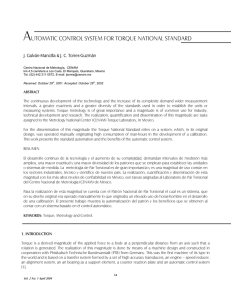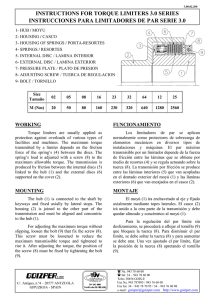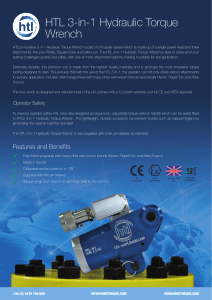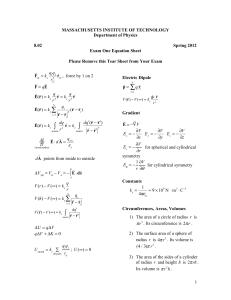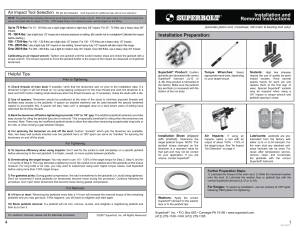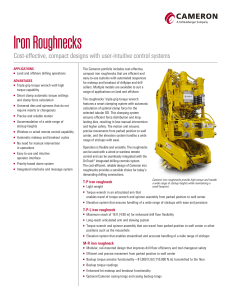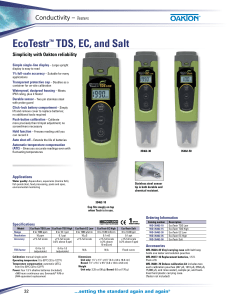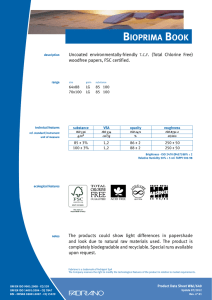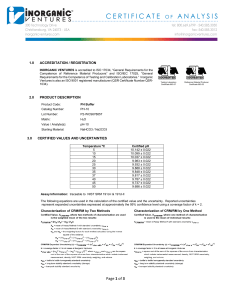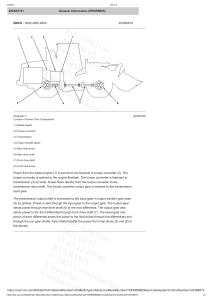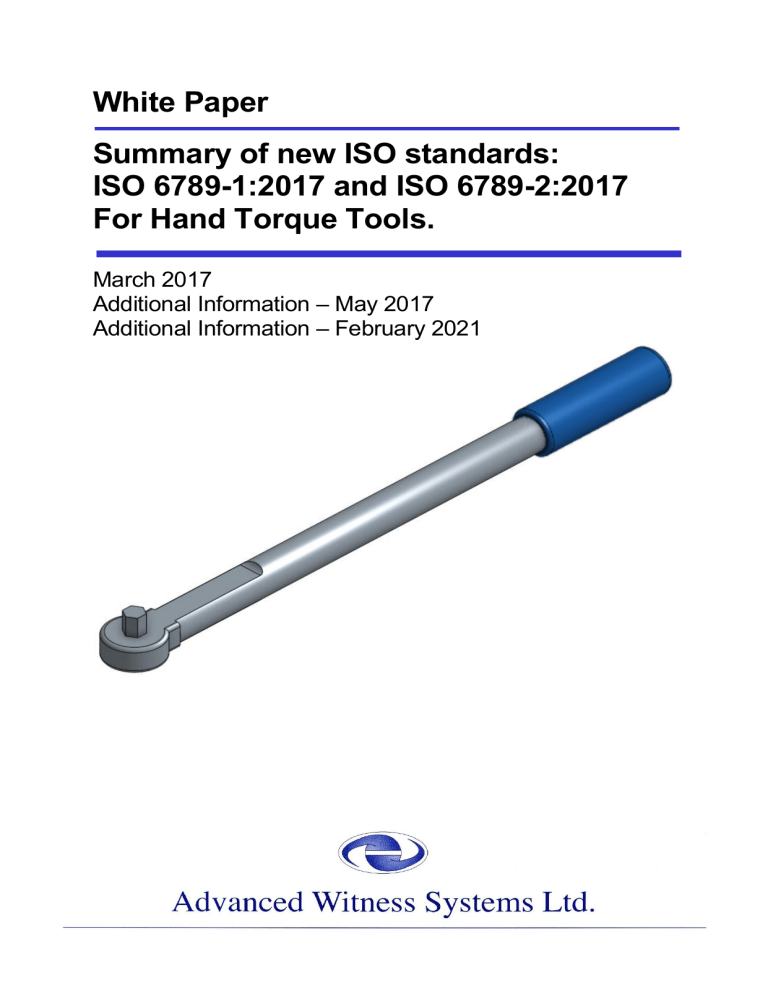
White Paper Summary of new ISO standards: ISO 6789-1:2017 and ISO 6789-2:2017 For Hand Torque Tools. March 2017 Additional Information – May 2017 Additional Information – February 2021 1. Introduction This paper gives a brief summary of the main differences between the new standard, ISO 6789:2017 parts 1 & 2, and the standard it has superseded, ISO 6789:2003. We have updated the paper to include further information regarding the calibration timing requirements and information on calibrating torque screwdrivers and their calibrating timing requirements. This additional information has been included in Section 3 and 4, titled Update February 2021. The standard has evolved from 1 single 22 page document to 2 documents totalling 63 pages, with annexes. Whilst this at first appears a huge change, it is hoped this short briefing paper will explain some of the more notable differences. 2. ISO 6789-1:2017 (Part 1) Part 1 is much like the superseded standard, and concerns the performance and conformity of the torque tool. On the whole this has not changed, apart from more detailed clarification in certain areas, such as the specified measuring range and the torque tool scales, dials and displays. The new standard does add a section on the effect of geometric changes of the torque tool, on the torque value, and dependent on the load application point. The most notable addition is the requirement for a Declaration of Conformance, which must be supplied with the tool. The standard details the required contents of this declaration. These consist of 16 items. 3. ISO 6789-2:2017 (Part 2) Part 2 concerns the calibration of the torque tool, and requirements of the testing equipment. Additionally is the inclusion of uncertainties of the calibration. This comprises of 7 uncertainties. These being: 𝑤𝑟 − 𝑈𝑛𝑐𝑒𝑟𝑡𝑎𝑖𝑛𝑡𝑦 𝑑𝑢𝑒 𝑡𝑜 𝑡ℎ𝑒 𝑣𝑎𝑟𝑖𝑎𝑡𝑖𝑜𝑛 𝑖𝑛 𝑡ℎ𝑒 𝑠𝑐𝑎𝑙𝑒, 𝑑𝑖𝑎𝑙 𝑜𝑟 𝑑𝑖𝑠𝑝𝑙𝑎𝑦 𝑟𝑒𝑠𝑜𝑙𝑢𝑡𝑖𝑜𝑛 𝑤𝑟𝑒𝑝 − 𝑈𝑛𝑐𝑒𝑟𝑡𝑎𝑖𝑛𝑡𝑦 𝑑𝑢𝑒 𝑡𝑜 𝑟𝑒𝑝𝑟𝑜𝑑𝑢𝑐𝑖𝑏𝑖𝑙𝑖𝑡𝑦 𝑜𝑓 𝑡𝑜𝑟𝑞𝑢𝑒 𝑡𝑜𝑜𝑙𝑠 𝑤𝑜𝑑 − 𝑈𝑛𝑐𝑒𝑟𝑡𝑎𝑖𝑛𝑡𝑦 𝑑𝑢𝑒 𝑡𝑜 𝑔𝑒𝑜𝑚𝑒𝑡𝑟𝑖𝑐 𝑒𝑓𝑓𝑒𝑐𝑡𝑠 𝑜𝑓 𝑡ℎ𝑒 𝑜𝑢𝑡𝑝𝑢𝑡 𝑑𝑟𝑖𝑣𝑒 𝑜𝑓 𝑡ℎ𝑒 𝑡𝑜𝑟𝑞𝑢𝑒 𝑡𝑜𝑜𝑙 𝑤𝑖𝑛𝑡 − 𝑈𝑛𝑐𝑒𝑟𝑡𝑎𝑖𝑛𝑡𝑦 𝑑𝑢𝑒 𝑡𝑜 𝑔𝑒𝑜𝑚𝑒𝑡𝑟𝑖𝑐 𝑒𝑓𝑓𝑒𝑐𝑡𝑠 𝑜𝑓 𝑡ℎ𝑒 𝑖𝑛𝑡𝑒𝑟𝑓𝑎𝑐𝑒 𝑏𝑒𝑡𝑤𝑒𝑒𝑛 𝑡ℎ𝑒 𝑜𝑢𝑡𝑝𝑢𝑡 𝑑𝑟𝑖𝑣𝑒 𝑜𝑓 𝑡ℎ𝑒 𝑡𝑜𝑟𝑞𝑢𝑒 𝑡𝑜𝑜𝑙 𝑎𝑛𝑑 𝑡ℎ𝑒 𝑐𝑎𝑙𝑖𝑏𝑟𝑎𝑡𝑖𝑜𝑛 𝑠𝑦𝑠𝑡𝑒𝑚 𝑤𝑙 − 𝑈𝑛𝑐𝑒𝑟𝑡𝑎𝑖𝑛𝑡𝑦 𝑑𝑢𝑒 𝑡𝑜 𝑡ℎ𝑒 𝑣𝑎𝑟𝑖𝑎𝑡𝑖𝑜𝑛 𝑜𝑓 𝑡ℎ𝑒 𝑓𝑜𝑟𝑐𝑒 𝑙𝑜𝑎𝑑𝑖𝑛𝑔 𝑝𝑜𝑖𝑛𝑡 𝑤𝑟𝑒 − 𝑈𝑛𝑐𝑒𝑟𝑡𝑎𝑖𝑛𝑡𝑦 𝑑𝑢𝑒 𝑡𝑜 𝑡ℎ𝑒 𝑟𝑒𝑝𝑒𝑎𝑡𝑎𝑏𝑖𝑙𝑖𝑡𝑦 𝑤𝑚𝑑 − 𝑅𝑒𝑙𝑎𝑡𝑖𝑣𝑒 𝑠𝑡𝑎𝑛𝑑𝑎𝑟𝑑 𝑚𝑒𝑎𝑠𝑢𝑟𝑒𝑚𝑒𝑛𝑡 𝑢𝑛𝑐𝑒𝑟𝑡𝑎𝑖𝑛𝑡𝑦 𝑜𝑓 𝑡ℎ𝑒 𝑚𝑒𝑎𝑠𝑢𝑟𝑒𝑚𝑒𝑛𝑡 𝑑𝑒𝑣𝑖𝑐𝑒 𝑎𝑡 𝑡ℎ𝑒 𝑡𝑎𝑟𝑔𝑒𝑡 𝑡𝑜𝑟𝑞𝑢𝑒 It takes into consideration not only the torque tool itself, the variables such as its square drive and possible load application points, but also the adapter on the torque tool and test equipment. It details how a number of extra operations of the torque tool have to be performed in order to quantify these uncertainties and for compliance with the new standard. This full calibration process requires that the number of testing operations increases from 35 in the old standard, and to a maximum of 153 in the new. PAGE 1 OF 4 For example, for each direction of calibration, the number of testing operations (exercises (Ex) and readings (Re)) for each type & class of torque tool will be: Type & Class All Type I. Type II Classes A, D & G Type II Classes B, C, E & F Recorded Measurements for Calibration Ex Re Uncertainties Re Ex Re Ex Re Ex Re Total Number of Testing Operations 𝒘𝒓𝒆𝒑 𝒘𝒐𝒅* 𝒘𝒊𝒏𝒕 * 𝒘𝒍 * 3 15 20 5 40 5 40 5 20 153 3 10 0 5 40 5 40 5 20 128 *Note: It is to be hoped that manufacturers can type test 10 of each of their models(or the same wrench 10 times) to provide the variation figures (𝑏𝑜𝑑 , 𝑏𝑖𝑛𝑡 , 𝑏𝑙 ) as default values, which can be used to generate the uncertainty figures (𝑤𝑜𝑑 , 𝑤𝑖𝑛𝑡 , 𝑤𝑙 respectively) to reduce the number of tests performed by the calibration laboratories. If all of these are supplied by the manufacturer, the total number of testing operations is reduced by 115. It also requires control of the adapters, these ideally being precision adapters, which are permanently identified, recorded, and will assist in reducing the uncertainties of measurement. Annex C outlines the method and minimum requirements for the calibration of the torque measurement device, and the estimation of its measurement uncertainty. However, the standard allows for existing torque calibration standards, such as the BS7882 standard to be used where the calibration laboratory is operating to the ISO 17025 standard, and as such has traceability. Additional Information – May 2017: It is to be noted that Tolerances, as specified, are ±4% or ±6% depending upon range, are applicable to the certificate of conformity only. Conformity to 6789-1 calculates the Relative Measurement Deviation differently than 6789-2 calibration Relative Measurement Error. The result of this is that though a new wrench could be shown to conform to the tolerance requirements, and immediate calibration could show the measurement error to be outside of the ±4% or ±6%. This could present difficulties for manufacturers, users and accreditation authorities. Additional Information – February 2021: The standard has a table detailing the minimum times dependant on the torque value set. These minimum times are applied for the last 20% of the torque value set. Whilst very open, control of the start of the last 20% and ensuring that the calibration force application exceeds the minimum times is manually demanding and better controlled by powered automation. Calibration of torque screwdrivers is even more demanding. Though less is stated in the calibration requirements, a simple one line statement that the time for the last 20% of the setting torque shall be within 0.5 to 1.0 seconds no matter what the torque setting is more of a demand. Not mentioned but found during calibration are the differences in cam operation screwdrivers of the variance of the different cam positions. An automated method of learning and then calibrating for these cam position variations allows for control within the timing tolerances allowed. PAGE 2 OF 4 4. Summary There are large implications for the calibrators and manufacturers of torque tools, maintaining their quality control and accreditation, and thereby conforming to this revised standard. All the above can be quite onerous in its own right and additional calculations require comprehensive spreadsheets. Advanced Witness Systems Ltd (AWS Ltd) can greatly assist in this with its new Kepler 4 software program to lead and control both the process in calibration, to produce the required results and certificates. AWS Ltd can provide a short course on the detail of the standard when required. Update February 2021 We also manufacture the calibration machines for torque wrenches of all sizes and for Torque Screwdrivers. Additionally, we can provide precision calibration adapters and calibration instruments to fulfil the need. Please see our website www.awstorque.co.uk or contact us for more information, as well as reading our document on solutions to ISO 6789:2017 problems. Advance notification As the standard has now been in use for four years a number of issues have arisen from users. We will be detailing these in a further white paper to be published soon. Disclaimer: The information in this white paper is believed to be fair and accurate but represents the view of the staff of AWS Ltd. and should not be used for any specific purpose other than that intended, which is to encourage further questions, understanding and debate of the new standard. © Advanced Witness Systems Ltd. 2021 PAGE 3 OF 4 Advanced Witness Systems Ltd. Unit 8 Beaumont Business Centre, Beaumont Close, Banbury. OX16 1TN Tel: +44 (0) 1295 266939 Email: [email protected] www.awstorque.co.uk Registered in England Company Number: 2565074 PAGE 4 OF 4
